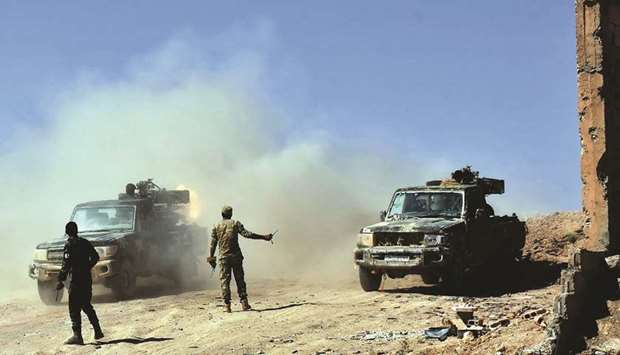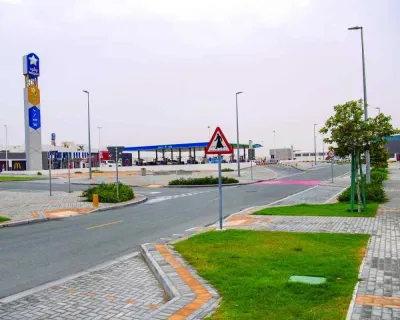A US-backed force battling the Islamic State group in eastern Syria accused Russian warplanes on Saturday of bombing its fighters for the first time in the complex war.
But Russia's military spokesman denied targeting the Syrian Democratic Forces, an alliance of Arab and Kurdish fighters supported by Washington.
‘This is not possible. Why would we bomb them?’ military spokesman Igor Konashenkov told AFP at the Hmeimim base, Moscow's main outpost for its air operations in Syria.
The SDF and Russian-backed Syrian government forces are conducting parallel but separate offensives against IS in the strategic and oil-rich eastern province of Deir Ezzor.
Regime troops are waging an assault for the provincial capital, Deir Ezzor city, while SDF fighters battle the jihadists further east across the Euphrates River.
The SDF earlier said six of its fighters were wounded in Russian and regime bombing of an industrial area northeast of the city, about seven kilometres (four miles) from the east bank of the Euphrates.
‘At 3:30 am (0030 GMT) on September 16, 2017, our forces east of the Euphrates River were targeted by Russian and Syrian regime warplanes in the Al-Sinaaiya area,’ the SDF said.
‘At a time when the SDF's brave forces are scoring great victories against IS in Raqa and Deir Ezzor... some parties are trying to create obstacles to our progress,’ the statement said.
- De-confliction line -
The SDF's assaults against IS in Deir Ezzor and in Raqa further up the Euphrates Valley are both backed by the US-led coalition, while Syrian regime troops are getting air cover from Russia.
SDF fighters say they not coordinating their Deir Ezzor operations with the government or Russia.
But the coalition says there is a de-confliction line to prevent the two offensives from clashing.
The line agreed between Russia, the regime, the SDF and the coalition runs from Raqa province southeast along the Euphrates River to Deir Ezzor.
The skies over Syria have become increasingly congested as the six-year conflict has dragged on, with warplanes from the coalition, the Syrian government and Russia all carrying out air strikes.
Confrontations between the warplanes have been rare, but in June a US fighter jet shot down a Syrian warplane accused of bombing SDF units in the north.
On Friday, top adviser to Syrian President Bashar al-Assad Bouthaina Shaaban told Al-Manar television that it was up to Russia and the US to see that the SDF and Syria's army do not clash.
‘Whether it's the SDF, Daesh, or any illegitimate foreign forces... we will work against them until all our land is liberated,’ she told the channel which is run by allied Lebanese movement Hezbollah.
‘It's the role of Russia and America to see that this confrontation doesn't take place,’ she said.
Syria's crisis erupted with protests demanding the ouster of Assad in 2011, but it has since morphed into a complex, multi-front war that has killed 330,000 people and displaced millions.
- Dwindling territory -
IS, which in 2014 overran swathes of territory across Syria, is seeing its zones of control dwindle even as it claims responsibility for bloody attacks abroad.
It once held most of Deir Ezzor province and its capital, encircling around 100,000 civilians that still lived in government-controlled neighbourhoods there.
But Russian-backed troops breached the IS sieges on the city earlier this month and are now working to shut off the jihadists' remaining escape routes.
IS ‘left and will never come back, God willing!’ said a silver-bearded man behind a vegetable stall in Deir Ezzor this week.
‘With the efforts of the Syrian, Russian, and Iranian armies, (IS) has gone to hell,’ he added.
Pro-regime forces had also begun fighting to reach the IS-held town of Albukamal, according to a statement published by a joint operations room of loyalists including Iranian, Iraqi, and Lebanese fighters from Hezbollah.
Albukamal lies on Syria's eastern border with Iraq and is regularly targeted by coalition air strikes.
IS has also been pushed out of two-thirds of its former bastion Raqa by the SDF.
And in desert territory just across the border in Iraq, security forces backed by tribal fighters are manoeuvring to attack one of IS's last remaining bastions.
After driving IS out of Nineveh province earlier this year, the Iraqi government set its eyes on Hawija, north of Baghdad, as well as the towns of Al-Qaim, Rawa and Anna in the western desert.
On Saturday, Iraqi government forces captured the former mining town of Akashat some 100 kilometres (60 miles) south of Al-Qaim just hours after attacking the IS desert outpost.



